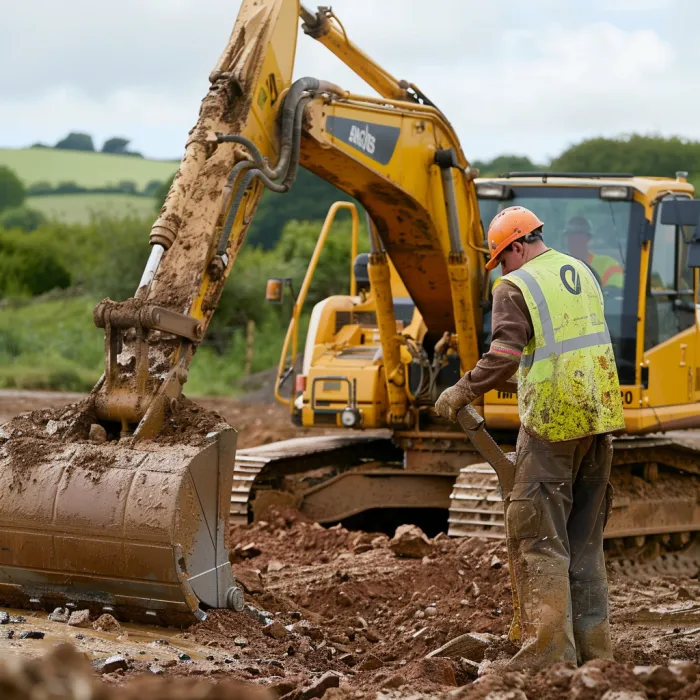
Whats the difference between 2D and 3D machine control?
The primary distinction between 2D and 3D excavator machine control systems lies in the technology they employ to provide positioning assistance and guidance solutions. While both systems aim to enhance tool positioning, they achieve this goal through different means.
These models provide precise, real-time information to machine operators, enabling them to work more accurately, efficiently, and safely.


Can 2D and 3D machine control systems be used together on the same project?
Yes, it is possible to use both 2D and 3D machine control systems on the same project, depending on the specific requirements of each task. For example, you may use a 3D system for complex grading and excavation work that requires precise positioning, while employing a 2D system for simpler tasks like trenching or mass excavation. This hybrid approach can help optimise costs and efficiency by allocating the appropriate technology to each task.
How does the learning curve differ between 2D and 3D machine control systems?
The learning curve for 2D machine control systems is generally shorter and less steep compared to 3D systems. Operators can typically familiarise themselves with 2D systems and their functionalities within a few hours, as the technology is less complex and relies on more traditional reference points like physical landmarks and stakes.
In contrast, 3D machine control systems require more extensive training, as operators need to understand how to interpret digital site plans, work with GPS technology, and leverage the advanced features offered by the system. This learning process may take several days or even weeks, depending on the operator's prior experience and technical aptitude.
What is the role of data preparation in 3D machine control systems?
Data preparation plays a crucial role in the effectiveness and accuracy of 3D machine control systems. Before work can begin on-site, detailed 3D models of the project must be created using CAD software or other specialised tools. These models include information such as terrain data, design surfaces, and grade specifications.
The quality and accuracy of these 3D models directly impact the performance of the machine control system. Any errors or discrepancies in the data can lead to costly rework and delays. As a result, it is essential to allocate sufficient time and resources to the data preparation process and to work closely with experienced professionals who can ensure the models meet the highest standards of accuracy and completeness.
How do 2D and 3D machine control systems impact operator fatigue and productivity?
Both 2D and 3D machine control systems can help reduce operator fatigue and improve productivity, but they achieve these benefits in different ways.
2D systems streamline the excavation process by providing real-time depth and distance information, eliminating the need for operators to constantly check grade stakes or manually measure progress. This allows operators to focus more on the task at hand, reducing mental strain and fatigue.
3D systems take this a step further by providing a comprehensive, real-time view of the project, including the exact position of the machine in relation to the desired grade. This level of detail and automation significantly reduces the mental workload on the operator, allowing them to work more efficiently and with greater precision. Additionally, the increased accuracy of 3D systems minimises the need for rework, further boosting productivity and reducing operator fatigue over the course of the project.
What factors should be considered when calculating the ROI of implementing a machine control system?
When calculating the return on investment (ROI) for implementing a 2D or 3D machine control system, consider the following factors:
- Initial hardware and software costs
- Installation and setup expenses
- Training costs for operators and support staff
- Potential productivity gains and time savings
- Reduced material costs due to increased accuracy
- Fuel savings from optimised machine operation
- Minimised rework and associated labour costs
- Improved safety and reduced risk of accidents or damage
- Longer-term benefits such as increased competitiveness and ability to take on more complex projects
By carefully analysing these factors and comparing them against your current operating costs and project requirements, you can develop a clearer picture of the potential ROI for implementing a 2D or 3D machine control system in your business.
2D control systems rely on physical landmarks, stakes, or laser technology to establish benchmarks and references throughout the excavation process. This approach provides essential information to the operator, such as excavation depth and distance, enabling them to maintain accuracy and efficiency.
On the other hand, 3D control systems leverage advanced GPS machine control technology to digitally project site plans and generate real-time data for precise positioning. This technology allows operators to view the exact location of the machine in relation to the desired grade, reducing the need for manual stake placement and constant recalibration.
How do 2D machine control systems work, and what are their benefits?
2D excavator control systems offer a cost-effective solution for smaller and more straightforward projects. These systems use physical landmarks, stakes, or laser technology to create accurate benchmarks, which the operator can reference during the excavation process. By providing essential information such as depth and distance, 2D systems help improve accuracy and efficiency.
The benefits of 2D machine control systems include:
- Improved safety and cost savings
- Maximised machine utility
- Minimal training time required
- Accurate grade and excavation work
- Easy adoption and implementation
- Optimised for mass excavation
- Slope control capabilities
- Real-time depth and distance information
While 2D systems may not be as advanced as their 3D counterparts, they offer a range of tangible benefits that can significantly enhance productivity and accuracy on specific projects.
How do 3D GPS machine control systems work, and what advantages do they offer?
3D GPS machine control systems represent the leading solution for machine guidance and precise positioning. These systems utilise advanced technologies, such as GPS, antennas, or local positioning systems (LPS), to track the exact location of the machine and generate digital terrain models in real-time.
By positioning digital site plans in front of the machine operator, 3D systems provide exact grade location information, reducing the need for manually set stakes and enabling operators to work with unparalleled accuracy and efficiency.
The primary benefits of 3D GPS machine control systems include:
- Live depth, distance, and grade data
- Unmatched accuracy and precise locating
- Elevation reference capabilities
- Site optimisation and streamlined workflows
- Significant reduction in downtime
- Minimised fuel wastage and increased sustainability
Although 3D systems come with a higher upfront cost and require more complex training, they offer a greater return on investment for larger and more intricate projects.
How can you determine which machine control system is best suited for your project?
To identify the optimal machine control system for your project, consider the following factors:
- Price: 2D systems are more cost-effective, while 3D systems offer enhanced functionality at a higher price point. Evaluate your budget and the potential return on investment for each option.
- Time: Consider both staff training time and potential time savings during the project. 3D systems may require longer training periods but can significantly reduce downtime by eliminating the need for manual stake placement and constant recalibration.
- Functionality: Assess the level of accuracy and functionality required for your project. If you need advanced features like digital site plan integration and exact machine positioning, a 3D system may be the better choice. However, if your project primarily involves measuring depth and distance, a 2D system could suffice.
By carefully evaluating these factors and aligning them with your project's unique specifications, you can make an informed decision on whether a 2D or 3D excavator machine control system will best serve your needs and facilitate optimal results.